As ambulances at a Vacaville hospital speed off to their next patient, an ultrasmart, energy-efficient system is lighting the way. Installed in partnership with the University of California, Davis, the lighting system now illuminates the emergency vehicle routes, parking lots and outdoor walkways of the NorthBay VacaValley Hospital. The system is reducing outdoor lighting energy use at the 24-hour site by 66 percent, saving about 29,000 kilowatt-hours annually -- enough to offset the greenhouse gas emissions of 7.2 tons of waste.
The project is the first comprehensive study of “networked adaptive” outdoor lighting for the health care sector and could lead the way to more efficient lighting at other hospitals. Adaptive lighting uses tools such as occupancy sensors to adjust lighting to suit activity levels.
“This project is an excellent example of UC Davis innovation making an impact beyond the campus,” said professor Michael Siminovitch, director of the California Lighting Technology Center at UC Davis. “Adaptive lighting systems consistently achieve deep energy savings and reduce facility costs while streamlining maintenance. Hospitals nationwide will benefit by looking to this project as a model.”
The outdoor lighting system was first demonstrated at UC Davis. As part of its Smart Lighting Initiative, the university in 2012 unveiled a campuswide exterior lighting retrofit designed by the California Lighting Technology Center that has reduced the campus's exterior lighting energy use by 86 percent (1,231,758 kwh annually), saving at least $120,900 in annual energy and maintenance costs.
At the hospital, a total of 57 lights were replaced with dimmable LEDs. Motion sensors, including a new type of long-range microwave sensor, control the lights so that energy use automatically drops when areas are vacant, yet plenty of light is available when and where staff and visitors need it.
To confirm this, the project team surveyed doctors, nurses, security guards and other hospital staff as part of the study. About 88 percent of those surveyed offered positive feedback on the quality of the new lighting.
“We’re thrilled to work with UC Davis to put their expertise and technology into action at our facility,” said Dave Mathews, senior director of plant operations and general services for NorthBay Healthcare. “It’s our honor to be part of the first comprehensive study of network adaptive outdoor lighting for the health care sector, potentially transforming the energy efficiency of outdoor hospital lighting nationwide. Not only does this free up more financial resources for patient care, it’s the right thing to do environmentally.”
The lights are also connected to a wireless network lighting control system that lets facility managers monitor energy use, make adjustments and receive alerts when a light requires maintenance.
CLTC recently received an award for its work on the project, winning “Best Use of Lighting Controls in a Single Facility” from the Lighting Energy Efficiency in Parking Campaign. LEEP Campaign winners have saved a total of nearly 45 million kwh and $4 million per year by upgrading to energy-efficient lighting.
The NorthBay VacaValley project is led by CLTC and Lawrence Berkeley National Laboratory in coordination with the Better Buildings Alliance Lighting & Electrical Project Team and Pacific Northwest National Laboratory. It was partially funded by Commercial Building Integration within the Building Technologies Program, Office of Energy Efficiency and Renewable Energy, and the U.S. Department of Energy. Siemens served as the energy services company for the project, managing both indoor and outdoor retrofits, facilitating contracting for the work and guaranteeing savings for the hospital.
About Siemens
The Siemens Building Technologies Division is the world leader in the market for safe and secure, energy-efficient and environment-friendly buildings and infrastructures. As technology partner, service provider, system integrator and product vendor, Building Technologies has offerings for safety and security as well as building automation, heating, ventilation and air conditioning (HVAC) and energy management. With around 28,000 employees worldwide, Building Technologies generated revenue of approx. 5.8 billion Euro. For more information, visit http://www.usa.siemens.com/buildingtechnologies.
About NorthBay VacaValley Hospital
NorthBay VacaValley is a 50-bed nonprofit community hospital providing 24-hour emergency care, intensive care, and sophisticated surgical and diagnostic services. The campus also features an ambulatory surgery center and specialty services. In 2015 it will add a state-of-the-art cancer center, as well as Wellness Center featuring a new medical fitness program.
About CLTC
The California Lighting Technology Center is a not-for-profit RD&D facility dedicated to developing and commercializing energy-efficient lighting and daylighting technologies. Part of the Department of Design at the University of California, Davis, CLTC includes full-scale laboratories for research and development. Staff members instruct undergraduate and graduate students of lighting design, and they provide courses and educational resources to professionals seeking advanced training.
Media Resources
Kat Kerlin, Research news (emphasis on environmental sciences), 530-750-9195, kekerlin@ucdavis.edu
Kelly Cunningham, California Lighting Technology Center at UC Davis, (530) 747-3824, kcunning@ucdavis.edu
Diane Barney, NorthBay Healthcare, (707) 646-3304, DBarney@NorthBay.org
Allison Britt, Siemens, (847) 941-5724, allison.britt@siemens.com
